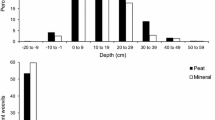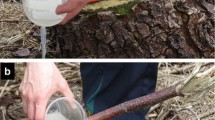Abstract
The large pine weevil Hylobius abietis is an important pest of reforestation in northern Europe. In field trials, we assessed the efficacy of entomopathogenic fungi (EPF) alone and in combination with entomopathogenic nematodes (EPN) against immature stages. We used commercial strains of Metarhizium brunneum and Beauveria bassiana and a strain of Beauveria caledonica isolated from the pest’s habitat. The EPN used were Steinernema carpocapsae and Heterorhabditis downesi. Efficacy was assessed by weevil infection in stumps and by numbers of adult weevils emerging in traps above the stumps. EPF infected up to 23% of pine weevils, at depths up to 25 cm below ground. Three EPF application methods were compared, but application method did not affect infection rates. When applied at half doses, EPF and EPN had additive effects: M. brunneum and S. carpocapsae caused a reduction in emergence of 58% relative to control, M. brunneum and H. downesi 93%, B. caledonica and H. downesi 86%. EPN alone offered good suppression of H. abietis populations and suppression by the mixture did not surpass suppression afforded by EPN alone. Our trials show B. caledonica is a promising species, rivalling the success of the other two species. Applied EPF, especially M. brunneum, can persist for at least 2 years in the forest setting. Additionally, different fungi can have differential action against weevils above versus below ground; therefore, EPF combinations may be beneficial. Based on our trials, further development of strains and application methods are required before EPF can be recommended for suppression of pine weevil.







Similar content being viewed by others
Abbreviations
- EPF:
-
Entomopathogenic fungi
- EPN:
-
Entomopathogenic nematodes
References
Amiri-Besheli B, Khambay B, Cameron S, Deadman ML, Butt TM (2000) Inter-and intra-specific variation in destruxin production by insect pathogenic Metarhizium spp., and its significance to pathogenesis. Mycol Res 104:447–452
Anbesse SA, Adge BJ, Gebru WM (2008) Laboratory screening for virulent entomopathogenic nematodes (Heterorhabditis bacteriophora and Steinernema yirgalemense) and fungi (Metarhizium brunneum and Beauveria bassiana) and assessment of possible synergistic effects of combined use against grubs of the barley chafer Coptognathus curtipennis. Nematology 10:701–709
Ansari MA, Butt TM (2012) Susceptibility of different developmental stages of large pine weevil Hylobius abietis (Coleoptera: Curculionidae) to entomopathogenic fungi and effect of fungal infection to adult weevils by formulation and application methods. J Invertebr Pathol 111:33–40
Ansari MA, Tirry L, Moens M (2004) Interaction between Metarhizium brunneum CLO 53 and entomopathogenic nematodes for the control of Hoplia philanthus. Biol Control 31:172–180
Ansari MA, Shah FA, Tirry L, Moens M (2006) Field trials against Hoplia philanthus (Coleoptera: Scarabaeidae) with a combination of an entomopathogenic nematode and the fungus Metarhizium brunneum CLO 53. Biol Control 39:453–459
Ansari MA, Shah FA, Butt TM (2008) Combined use of entomopathogenic nematodes and Metarhizium brunneum as a new approach for black vine weevil, Otiorhynchus sulcatus, control. Entomol Exp Appl 129:340–347
Ansari MA, Shah FA, Butt TM (2010) The entomopathogenic nematode Steinernema kraussei and Metarhizium brunneum work synergistically in controlling overwintering larvae of the black vine weevil, Otiorhynchus sulcatus, in strawberry growbags. Biocontrol Sci Technol 20:99–105
Brixey JM, Moore R, Milner AD (2006) Effect of entomopathogenic nematode (Steinernema carpocapsae Weiser) application technique on the efficacy and distribution of infection of the large pine weevil (Hylobius abietis L.) in stumps of Sitka spruce (Picea sitchensis Carr.) created at different times. For Ecol Manag 226:161–172
Crawley MJ (1993) GLIM for ecologists. Blackwell Scientific Publications, Oxford
Dillon AB, Ward D, Downes MJ, Griffin CT (2006) Suppression of the large pine weevil Hylobius abietis (L.) (Coleoptera: Curculionidae) in pine stumps by entomopathogenic nematodes with different foraging strategies. Biol Control 38:217–226
Dillon AB, Downes MJ, Ward D, Griffin CT (2007) Optimizing application of entomopathogenic nematodes to manage large pine weevil, Hylobius abietis L. (Coleoptera: Curculionidae) populations developing in pine stumps, Pinus sylvestris. Biol Control 40:253–263
Dillon AB, Rolston AN, Meade CV, Downes MJ, Griffin CT (2008) Establishment, persistence, and introgression of entomopathogenic nematodes in a forest ecosystem. Ecol Appl 18:735–747
Draganova SA, Doychev DD, Pilarska DK, Takov DI (2017) Bioassays of entomopathogenic fungi against xylophagous insects in Bulgaria: laboratory and field experiments. Acta Zool Bulgar 69:411–419
Eckard S, Ansari MA, Bacher S, Butt TM, Enkerli J, Grabenweger G (2014) Virulence of in vivo and in vitro produced conidia of Metarhizium brunneum strains for control of wireworms. Crop Prot 64:137–142
Evans H, McAllister F, Saunders T, Moore R, Jenkins T, Butt T, Ansari M, Griffin C, Williams C, Teck R, Sweeney J (2015) The impact project guide to Hylobius management. http://www.impactproject.eu/uploads/impact_hylobius_publication.pdf. Accessed 31 July 2012
Glare TR, Reay SD, Nelson TL, Moore R (2008) Beauveria caledonica is a naturally occurring pathogen of forest beetles. Mycol Res 112:352–360
Goble TA, Gardescu S, Jackson MA, Hajek AE (2016) Evaluating different carriers of Metarhizium brunneum F52 microsclerotia for control of adult Asian longhorned beetles (Coleoptera: Cerambycidae). Biocontrol Sci Technol 26:1212–1229
Inglis GD, Johnson DL, Cheng KJ, Goettel MS (1997) Use of pathogen combinations to overcome the constraints of temperature on entomopathogenic hyphomycetes against grasshoppers. Biol Control 8:143–152
Inglis GD, Goettel MS, Butt TM, Strasser H (2001) Use of hyphomycetous fungi for managing insect pests. In: Butt TM, Jackson C, Magan N (eds) Fungi as biocontrol agents: progress, problems and potential. CAB International, Wallingford, pp 23–69
Kapranas A, Malone B, Quinn S, Mc Namara L, Williams CD, O’Tuama P, Peters A, Griffin CT (2017a) Efficacy of entomopathogenic nematodes for control of large pine weevil, Hylobius abietis: effects of soil type, pest density and spatial distribution. J Pest Sci 90:495–505
Kapranas A, Malone B, Quinn S, O’Tuama P, Peters A, Griffin CT (2017b) Optimizing the application method of entomopathogenic nematode suspension for biological control of large pine weevil Hylobius abietis. Biocontrol 62:659–667
Keller S, Schweizer C (2007) White grub control in golf courses. IOBC WPRS Bull 30:101–104
Lacey LA, Grzywacz D, Shapiro-Ilan DI, Frutos R, Brownbridge M, Goettel MS (2015) Insect pathogens as biological control agents: back to the future. J Invertebr Pathol 132:1–41
Långström B, Day KR (2007) Damage, control and management of weevil pests, especially Hylobius abietis. In: Lieutier F, Day KR, Battisti A, Grégoire J-C, Evans HF (eds) Bark and wood boring insects in living trees in Europe, a synthesis. Springer, Berlin, pp 415–444
Leather SR, Day KR, Salisbury AN (1999) The biology and ecology of the large pine weevil, Hylobius abietis (Coleoptera: Curculionidae): a problem of dispersal? Bull Entomol Res 89:3–16
Mc Namara (2016) Interactions of entomopathogenic fungi and other control agents: mechanism and field potential against Hylobius abietis. Dissertation, Maynooth University
Mc Namara L, Carolan JC, Griffin CT, Fitzpatrick D, Kavanagh K (2017) The effect of entomopathogenic fungal culture filtrate on the immune response of the greater wax moth, Galleria mellonella. J Insect Physiol 100:82–92
Moore R (2001) Emergence trap developed to capture adult large pine weevil Hylobius abietis (Coleoptera: Curculionidae) and its parasite Bracon hylobii (Hymenoptera: Braconidae). Bull Entomol Res 91:109–115
Ormond EL, Thomas APM, Pugh PJA, Pell JK, Roy HE (2010) A fungal pathogen in time and space: the population dynamics of Beauveria bassiana in a conifer forest. FEMS Microbiol Ecol 74:146–154
Popowska-Nowak E, Skrzecz I, Tumialis D, Pezowicz E, Samborska I, Góral K (2016) entomopathogenic fungi in the soils of forest plantations: towards the control of large pine weevil, Hylobius abietis. Balt For 22:8–15
Quesada-Moraga E, Vey A (2003) Intra-specific variation in virulence and in vitro production of macromolecular toxins active against locust among Beauveria bassiana strains and effects of in vivo and in vitro passage on these factors. Biocontrol Sci Technol 13:323–340
Reay SD, Brownbridge M, Cummings NJ, Nelson TL, Souffre B, Lignon C, Glare TR (2008) Isolation and characterization of Beauveria spp. associated with exotic bark beetles in New Zealand Pinus radiata plantation forests. Biol Control 46:484–494
Roy HE, Vega FE, Chandler D, Goettel MS, Pell J, Wajnberg E (eds) (2010) The ecology of fungal entomopathogens. Springer, Dordrecht
Scheepmaker JWA, Butt TM (2010) Natural and released inoculum levels of entomopathogenic fungal biocontrol agents in soil in relation to risk assessment and in accordance with EU regulations. Biocontrol Sci Technol 20(5):503–552
Shah FA, Ansari MA, Prasad M, Butt TM (2007) Evaluation of black vine weevil (Otiorhynchus sulcatus) control strategies using Metarhizium brunneum with sublethal doses of insecticides in disparate horticultural growing media. Biol Control 40:246–252
Torr P, Wilson MJ, Heritage S (2005) Forestry applications. In: Grewal PS, Ehlers RU, Shapiro-Ilan DJ (eds) Nematodes as biocontrol agents. CABI Publishing, Wallingford, pp 281–294
Torr P, Heritage S, Wilson MJ (2007) Steinernema kraussei, an indigenous nematode found in coniferous forests: efficacy and field persistence against Hylobius abietis. Agr For Entomol 9: 181–188
Wainhouse D, Boswell R, Ashburner R (2004) Maturation feeding and reproductive development in adult pine weevil, Hylobius abietis (Coleoptera: Curculionidae). Bull Entomol Res 94:81–87
Wakil W, Yasin M, Shapiro-Ilan D (2017) Effects of single and combined applications of entomopathogenic fungi and nematodes against Rhynchophorus ferrugineus (Olivier). Sci Rep 7:5971
Wegensteiner R, Tkaczuk C, Balazy S, Griesser S, Rouffaud MA, Stradner A, Steinwender BM, Hager H, Papierok B (2015) Occurrence of pathogens in populations of Ips typographus, Ips sexdentatus (Coleoptera, Curculionidae, Scolytinae) and Hylobius spp. (Coleoptera, Curculionidae, Curculioninae) from Austria, Poland and France. Acta Protozool 54:219–232
Williams CD, Dillon AB, Harvey CD, Hennessy R, Mc Namara L, Griffin CT (2013) Control of a major pest of forestry, Hylobius abietis, with entomopathogenic nematodes and fungi using eradicant and prophylactic strategies. For Ecol Manag 305:212–222
Wu S, Youngman RR, Kok LT, Laub CA, Pfeiffer DG (2014) Interaction between entomopathogenic nematodes and entomopathogenic fungi applied to third instar southern masked chafer white grubs, Cyclocephala lurida (Coleoptera: Scarabaeidae), under laboratory and greenhouse conditions. Biol Control 76:65–73
Acknowledgements
We thank Ben Malone and Lorna Tierney for their technical support. We thank numerous forest managers and technicians from Coillte, Ireland, for providing access to sites and helping with trials. This research was funded by the Irish Government (Department of Agriculture, Food and the Marine) under the National Development Plan 2007–2013.
Author information
Authors and Affiliations
Corresponding author
Ethics declarations
Conflict of interest
The authors declare that they have no conflict of interest.
Additional information
Communicated by S. T. Jaronskai.
Rights and permissions
About this article
Cite this article
Mc Namara, L., Kapranas, A., Williams, C.D. et al. Efficacy of entomopathogenic fungi against large pine weevil, Hylobius abietis, and their additive effects when combined with entomopathogenic nematodes. J Pest Sci 91, 1407–1419 (2018). https://doi.org/10.1007/s10340-018-0994-9
Received:
Revised:
Accepted:
Published:
Issue Date:
DOI: https://doi.org/10.1007/s10340-018-0994-9




